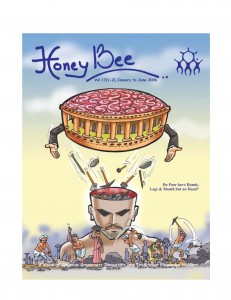A colonial legacy has been continued for over six decades and it seems will continue for some more time unless the NDA government decides to redefine what constitutes work. There could not be a bigger tragedy to consider more than 250 million people as ‘unskilled’ ignoring all the traditionally evolved knowledge systems and skills. Former President Dr A P J Abdul Kalam had written a letter to then Prime Minister to include not just menial but also mental work in the rural employment guarantee program. Some newspapers got wind of this and also published a news about the same sometime in 2006. There was a cover page ( see picture) brought out by Honey Bee Network at the same time entitled,” Do poor have hands, legs and mouth, No Head?”
After all, as argued by The Honey Bee Network for over 25 years, poor people are not poor in all the resources, they may be rich in ecological, biodiversity based knowledge, healing tradition, sculpting, painting, singing, composing, pottery, cooking, animal care and so on. But in the absence of market and vibrant policy avenues for valorizing these skills (except to a limited extent, by NIF), state policy defines them as unskilled labourers. If one wall of every school was painted by a local folk artists, will it not make learning environment vibrant and joyful. At the same time, artists will have got work for which he she can be paid. Likewise, all public offices can perk up working environment if one wall in each public office is painted by local artists every year. If wood and stone sculptors are invited one day a week to school to teach their skills to children, some respect for manual work and these arts will emerge. In addition, some children might like to pursue these as a vocation. Folk Singer can be invited to perform, and teach theit art, healers can be invited to share their inighst about the local biodiversity based knowledge system with highly effective, somewhat effective and occasionally effective solutions. Apart from respect for the local knowledge tradition, students will also develop skeptic attitude.
Not every thing in tradition is equally effective. Some traditions are actually not worth maintaining at all. Who will like tragic tradition of female foeticide using local material ot be maintained. Thus a healthy attitude toward tradition and modern technologies will emerge. Sonography machine might have been responsible for more female abortions than any other technology but then one can not ban use of sonograhy for other purposes. Idea is that while promoting the use of traditional skills, one should not promote blind reverence for these but a healthy skeptic attitude should be promoted.
There local communities can be asked to map biodiversity and other resources along with their uses in all the 650,000 villages of the country under MGNREGA. Similarly traditions of animal/human treatment can be mapped and then valorized as being done by NIF at a much larger scale.
The point is that out of 100 days of employment to be provided under MNGREA, at least 10 days could be earmarked for mapping and leveraging local resources and knowledge system associated with them. Fifty days worth advance may be given to a skilled person to start his/her local resource and knowledge based enterprise. In one year, even if one new enterprise is started in each village, one would have 650,000 start-ups in year. Cultural entrepreneurship will underline pluralistic nature of Indian polity. It will let hundred, nay thousand flowers bloom. Slowly, market will start emerging for traditional foods, skills, biodiversity based products, traditional crafts and textiles. More than that, work will be much more richly defined. A colonial legacy will be disrupted in support of entrepreneurial society. But will vested interests wanting continuance with obsolete definition of employment program let that happen? Time will tell, history will judge…


Good article Sir.
I liked the idea of inviting people like sculptors to the schools for children. Also right now what is happening in schools is that children are given projects for home and lot of paper and printer ink is wasted on such projects without any thought. In place of this if children are encouraged to use simple methods and material with the help of these creative and so called poor people (in reality they are quite rich) it will go a long way in developing really creative individuals for our country and the world.